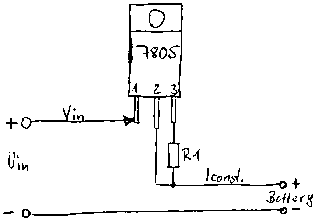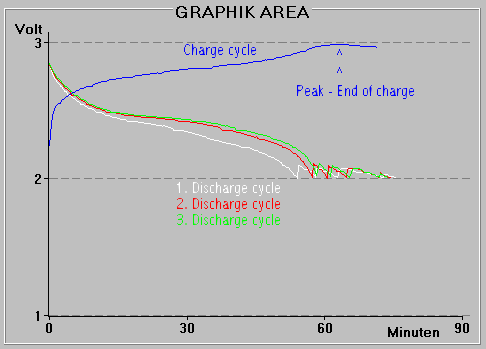| . |
| . |
| . |
| . |
| Rechargeables - The unknown species ... |
|
. After releasing Battery Control, I got alot of e-mails concerning the right way to handle rechargeables. So I decided to post a general information page about rechargeables. As a freelancing hardware developer, I designed a special charger for a customer a few years ago. Since then rechargeables became nearly a kind of obsession for me. The prototyp of the charger from then is still in my personal use and I still modify and add different charging algorithms (it's controlled by a 68000). Some of my many experiences I made you'll find below. . |
| . |
| . |
| . |
| . |

. |
If you're familiar with a soldering iron and you play around with electronics from time to time, you will probably know the fixed voltage regulators of the type 78XX, where XX stands for the voltage they'll output. They cost not even a dollar and you'll get them easily. It's very little known, that they make also an excellent constant current source. The input pin (1) remains standard, but instead of using the output pin (3), we draw the current from the normal ground pin (2). NOTE: The whole circuit has no ground connection. It's used like a resistor, the negative lead is directly connected to the battery. |
| There are some things to consider: Your input voltage *must* be much
higher than your battery voltage. First you have to compensate the nominal
regulation voltage, in the case of a 7805 5Volt (you can also use
a 7809 or 7812, but then you need 9 or 12V only to overcome that). Then,
the internal circuit 'eats' about 2V of semi-conductor loss and you need
about 2V/cell. While charging the voltage of a cell goes far above 1.2V.
Let's say you want to charge two AAA cells for your Palm, you need 5+2+(2*2)=11V
at least. So a cheap 12V plug-in power-supply is perfect. The resistor
for 50mA should be around 110 ohm *AND* it must be able to dissipate at
least 1Watt. You have only a 15V power supply? No problem, the current
remains constant until 35V input voltage (then you blow the 78XX), *BUT*
the power dissipation raises. So everything gets a bit hotter :) and you
might need to cool the 7805 and take a more powerful resistor. The same
applies, if you need more current. Making the resistor smaller increases
the current, taking a higher value decreases it. NiCad users with 250mAh
rechargeables should try it with 220ohm. A last note: Pin 2 is electrically
connected to the heat sink of the 7805, so take care when you fix it to
some metal parts! And don't leave the batteries connected to the charger
when it's not supplied. Depending on your input voltage power supply, the
batteries might be discharged again via the reverse path.
. |

. |
| BTW, this delta-peak is the major difference of NiCads and NiMHs. The
'peak' of NiMHs is much lower than the one of NiCads. So a charger suitable
for NiMHs must have a better A/D converter to detect that peak. Using a
bad NiCad charger for NiMHs can be fatal, though most chargers have an
additional time limit to avoid overcharging due to an overseen peak.
. What you see above, is the result of a very sophisticated process. One condition for a true voltage graph is that the charge current is switched of for a short moment (15mSec) while recording the voltage. That produces comparable graphs even when using different charge currents. To be able to use a current up to 4C (15 minutes charging time), another trick is necessary. The whole charging process is devided in 1 sec. portions. In every second, there are 3 phases: Phase 1 takes 980mSec - so most of the time - and the charge current is applied. Phase 2 takes 5mSec only and applies a relativ high *discharge* pulse (2.5C). Finally Phase 3 takes 15mSec and meassures the battery voltage in idle mode. The trick is phase 2. The discharge pulse helps immense to reabsorb the oxygen produced during the high charge current phase. Additionally it 'reconstructs' even older cells by 'smashing' crystals that grow too big during normal use. These crystals decrease the reaction surface of the chemicals inside the cell, such decreasing the ability to convert energy back and forth. The loss of charge with that pulse is minimal due to it's short duration. Together with that so called 'reflex-pulse' the charge efficieny increases also enormously. That means, when you charge the batteries 65 minutes with 1C they're full, and only 5 minutes of energy are lost in heat, pressure etc., all things a rechargeable doesn't like very much. In the graph above you can see also 3 discharge curves, which show the result of an refreshing process of old cells that were used with 'normal' chargers for half a year. Not only the overall capacity increases after 3 cycles, but also the voltage remains higher over the complete discharge time. . Ok, when you read all of the above and you do your own electronic experiments, you could build your own intelligent charger. You need a programmable current source for charging, a programmable current sink for the reflex pulse, an A/D converter to meassure the cell voltage and a processor to bring that all together :). But for the little AAA's for the Palm, it would be a bit of an overkill. My advice is to buy a good charger or, if you want to build your own one, look for ready available charging processors. Maxim and Linear Technologie for example offer a wide range for all kind of applications and battery types. . |
|
. Last updated: March 24th, 2000 Copyright © 1997-2000 by Peter Strobel, all rights reserved. |